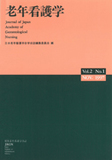Japanese
English
- 販売していません
- Abstract 文献概要
- 参考文献 Reference
目的:様々な種類の介護機器の中から,寝たきり予防の中心ともなる移動のための介護機器である移動用リフトおよび車椅子に注目し,以下の目的で研究を行った.
(1)移動用リフト・車椅子を利用している在宅要介護高齢者の実態を把握する.
(2)移動用リフト・車椅子の利用頻度による在宅要介護高齢者の特性を明らかにする.
(3)移動用リフト・車椅子の利用状況の実態を明らかにする.
方法:都内の2ヵ所の訪問看護ステーション利用者のうち,移動用リフト及び車椅子の利用者35名を対象に,家庭訪問による質問紙を用いた面接調査を実施した.
結果:要介護高齢者の年齢は80歳以上が全体の半数を占め,寝たきりの原因疾患は,脳血管障害が71.4%と最も多かった.ADLは,屋内での生活は何らかの介助を要するが,座位保持可能な対象が最も多く60.0%であった.移動用リフト・車椅子の利用時間によって,利用する対象の特徴に違いがみられ,また,その利用状況によって「室内型」,「室外型」,「室内・室外両用型」,「放置型」の4つのタイプに分類された.
結論:1.在宅で移動用リフト・車椅子を利用していた要介護高齢者の特徴は,後期高齢者であり,脳血管障害による寝たきりが多く,寝たきり期間は平均3.4年,ADLは座位保持に介助が必要な者が70%であり,QOLは比較的高かった.介護者は女性が約80%を占め,介護時間がほぼ終日であるのに対して,介護負担感は比較的低かった.
2.車椅子の利用頻度が高い要介護高齢者の特徴は,脳血管障害,片麻痺,座位保持可能な者が多く,QOLは比較的高かった.また,車椅子利用群が,車椅子利用なし群に比べてADL,QOLが高く,また,介護負担感が高い傾向が見られた.
3.車椅子の利用タイプは,「室内利用型」,「室外利用型」,「室内・室外両用型」,「放置型」に分類でき,それぞれのタイプに特徴があることがわかった.
Objective: To show the actual conditions of frail elderly people who use lifts and wheelchairs and to investigate differences in the types of lifts and wheelchairs used. We examined both demographic characteristics and the primary diagnoses of patients as they related to the frequency with which lifts and wheelchairs were used. We also considered situations in which lifts and wheelchairs are used to prevent patients from remaining bedridden.
DESIGN: A descriptive correlational study.
Setting: The data was collected from two visiting nursing service station in Tokyo. Thirty-five elderly people who were users of lifts and wheelchairs and who were visited by nurses from these stations were selected for the study. The interview survey consisted of semi-structured questionnaire which we administered ourselves.
Results: Half of the elderly patients were over 80 years old. The disease which had most frequently caused the patient to become bedridden was a cerebral infarction (71.4%). Of the patients surveyed, 60.0% required in-home help to assist them in their daily activities. Differences were also observed in the amount of time that the lifts and wheelchairs were used according to the characteristics of the individual patients. The group which was users of wheelchairs had a higher number of total points for abilities of daily living (ADL), The Quality of Life Scale (QOL-Scale; by Matsubayashi, et. al)and modified The Care Burden Scale (by Mizoguchi, et. al). The patients could be divided into 4 different types according to their level of wheelchair usage. There were "indoor types", "outdoor types", "indoor-outdoor types", and "no-use types".
Conclusions: We intend to do a prospective study about the way in which the use of lifts and wheelchairs relate to ADL, QOL, and modified The Care Burden Scale. This could allow for a system of support services related to these care devices, including guidelines for the use of the devices and information which could be made available to expert nurses caring for the to elderly and to places which provide new care devices to patients.
Copyright © 1997, Japan Academy of Gerontological Nursing All rights reserved.


